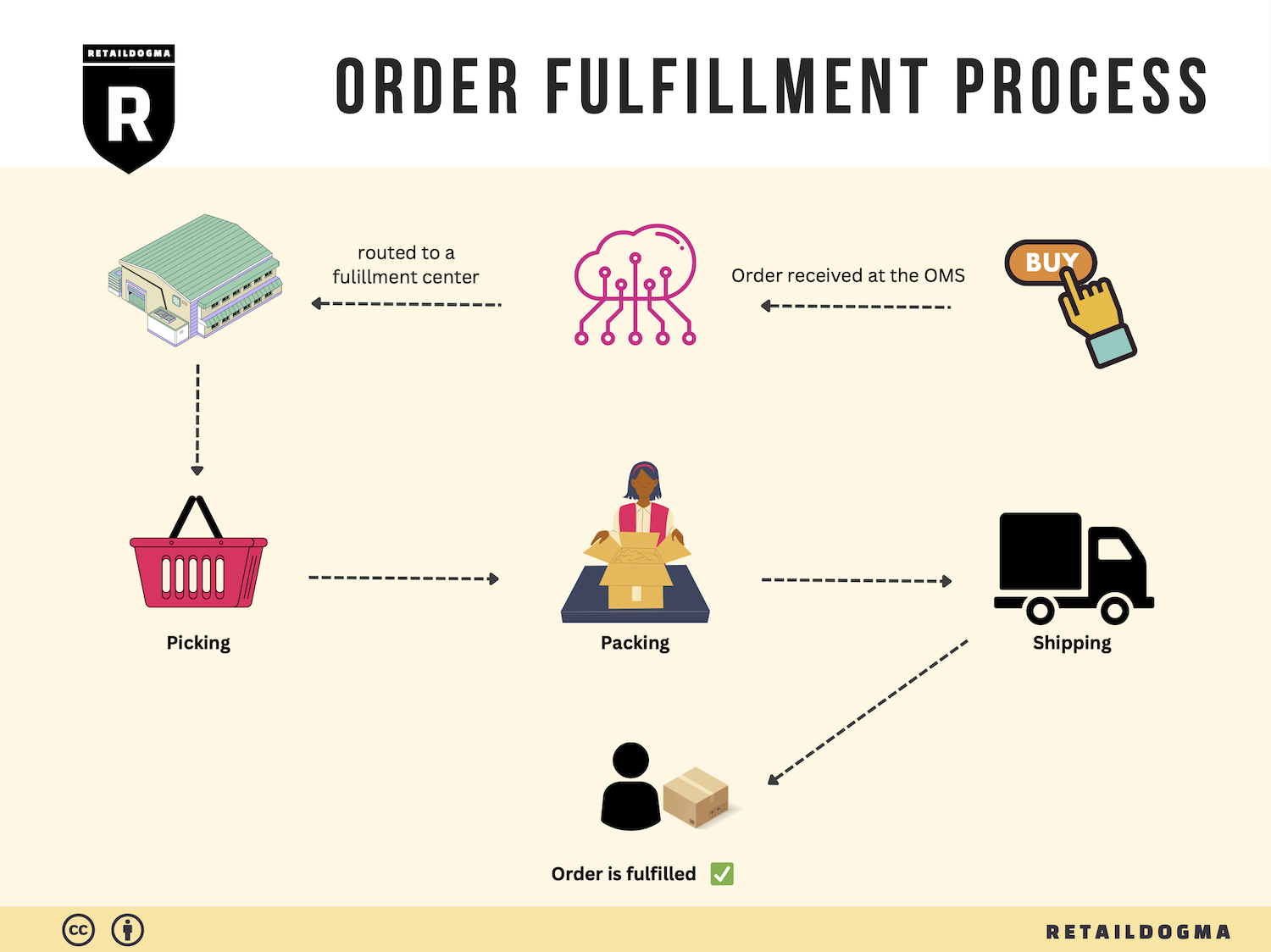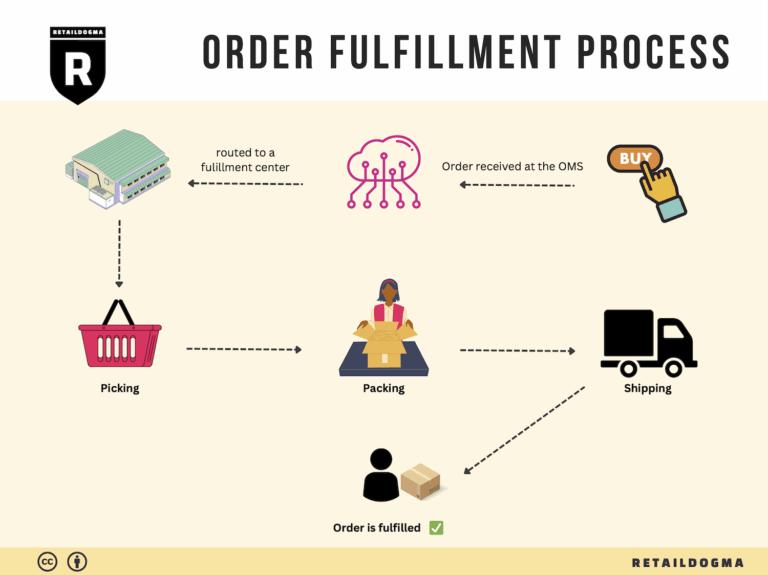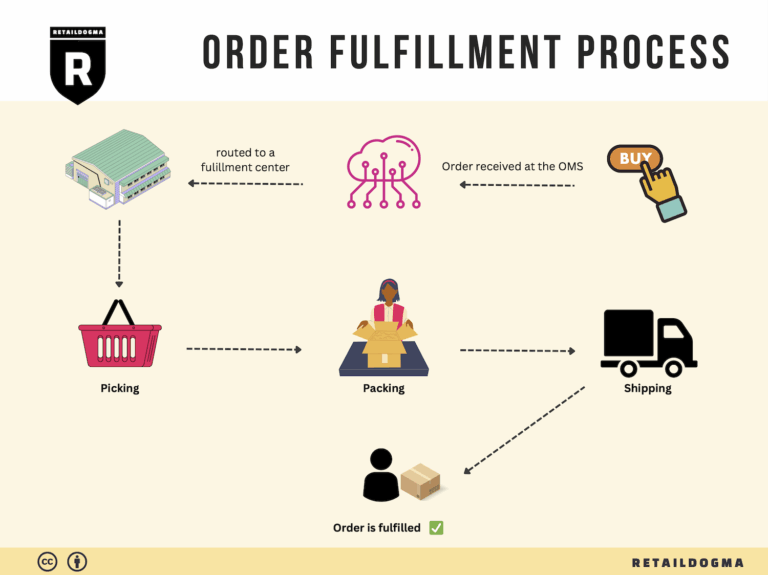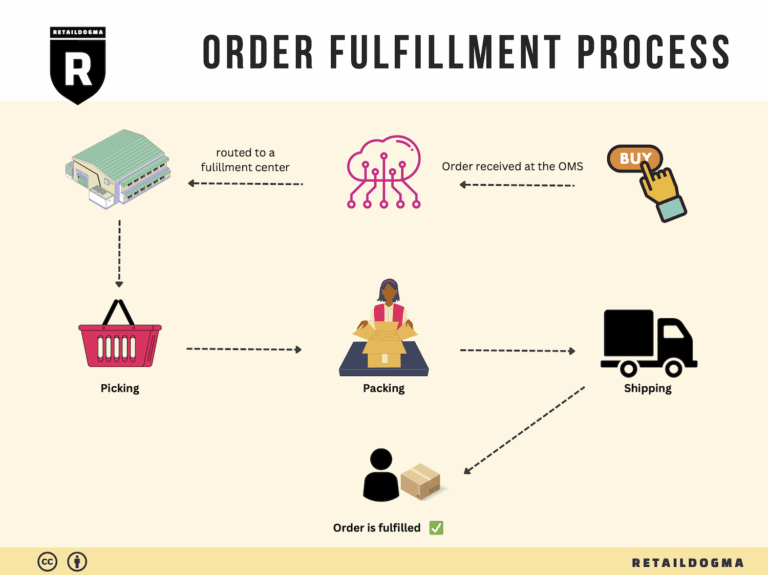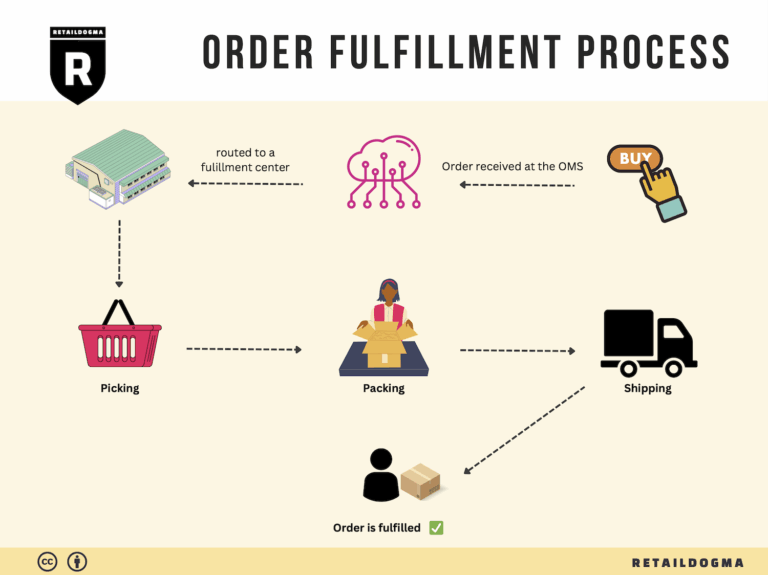What Is A Fulfillment Center? A Complete Guide (2025)
What is E-commerce Fulfillment? An Introduction for Growing Businesses
Understanding the E-commerce Fulfillment Process
As a growing e-commerce business, you might find yourself grappling with the complexities of packing and shipping orders. This overwhelming task can take a significant toll on your resources and time, diverting your focus from scaling your sales and enhancing customer experiences. E-commerce fulfillment is the critical process that ensures your products reach your customers efficiently and effectively. Simply put, it encompasses all the steps involved in getting a product from your inventory to the buyer’s doorstep.
In this guide, we will delve into the various aspects of e-commerce fulfillment that every business owner should understand. We will explore different fulfillment models, such as Third-Party Logistics (3PL) and Fulfillment by Amazon (FBA), to help you determine which best aligns with your operational needs and business goals. Each model comes with its own set of advantages and potential drawbacks, so understanding these will empower you to make informed decisions.
Moreover, we will outline the core services provided by fulfillment partners, including inventory management, order processing, packing, shipping, and returns handling. Knowing what services you can expect from a fulfillment provider is crucial for ensuring a seamless customer experience and maintaining operational efficiency.
Selecting the right fulfillment partner is a pivotal step in scaling your e-commerce operations. This guide will provide insights on how to evaluate potential partners based on their capabilities, technology, customer service, and geographic reach. We will also discuss key considerations for pricing, helping you understand how to negotiate costs and find a solution that fits your budget without compromising on quality.
Ultimately, the goal of this guide is to empower you with the knowledge and tools necessary to navigate the complexities of e-commerce fulfillment. By understanding the different options available and what to look for in a partner, you can make strategic logistics decisions that will not only streamline your operations but also enhance customer satisfaction and drive growth. Whether you are just starting or looking to optimize your existing fulfillment processes, this comprehensive guide aims to support you on your journey to success in the competitive e-commerce landscape.
What You’ll Learn In This Guide
- What is E-commerce Fulfillment? An Introduction for Growing Businesses
- The Order Fulfillment Process: From ‘Buy’ Button to Customer’s Door
- Comparing Fulfillment Models: In-House vs. 3PL vs. Dropshipping
- A Deep Dive into Amazon FBA: Pros, Cons, and Who It’s For
- Core Services Offered by Fulfillment Centers
- How to Choose a Fulfillment Partner: A 6-Point Checklist
- Understanding Fulfillment Pricing: A Breakdown of Common Fees
- Frequently Asked Questions (FAQs) about Fulfillment
- Conclusion: Is Outsourcing Fulfillment the Right Move for Your Business?
- Important Disclaimer
The Order Fulfillment Process: From ‘Buy’ Button to Customer’s Door
1. Receiving Inventory
The order fulfillment process begins with receiving inventory, which involves the acceptance of products from suppliers or manufacturers. This step is critical because it establishes the foundation for the entire fulfillment operation. Proper inventory management ensures that the right products are available when customers place orders.
Upon arrival, each shipment is inspected for quality and quantity, and items are logged into the inventory management system using Stock Keeping Units (SKUs). SKUs are unique identifiers that streamline tracking and organization. Accurate receiving minimizes discrepancies and ensures that inventory levels are correctly reflected in your system, preventing stockouts or overstock situations.
Importance: Efficient receiving reduces delays in order processing and enhances overall supply chain reliability. A well-organized receiving process contributes to better customer satisfaction by ensuring that products are available for quick order fulfillment.
2. Warehouse Storage
Once inventory is received, the next step is warehouse storage, where products are organized in a systematic manner within the fulfillment center. This involves categorizing items based on various factors such as size, weight, or product type, and placing them in designated storage locations.
Effective warehouse storage utilizes techniques like FIFO (First In, First Out) to manage perishable goods or fast-moving consumer products. The layout of the warehouse is also crucial; it should facilitate easy access to frequently picked items to optimize efficiency.
Importance: Proper storage strategies not only maximize space utilization but also enhance the speed of order picking. An organized warehouse reduces the time spent locating items, which is vital for meeting customer expectations in a fast-paced e-commerce environment.
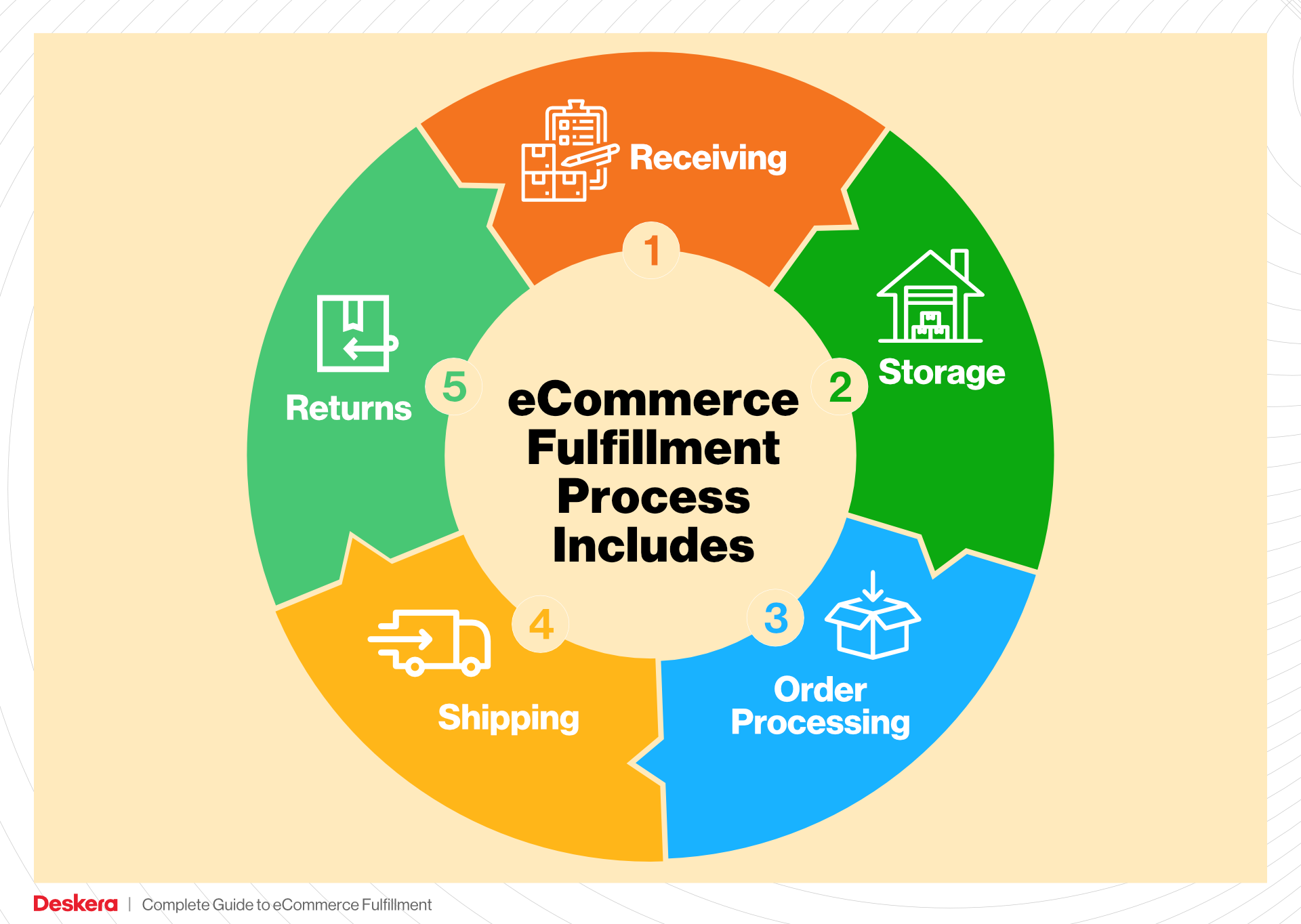
3. Order Picking
Order picking is the process of retrieving items from storage in response to customer orders. This step is often the most labor-intensive part of fulfillment and can significantly impact the efficiency of the operation. Businesses typically use pick lists—documents that outline which items and quantities to collect for each order.
Various picking methods exist, such as batch picking (picking multiple orders simultaneously) and zone picking (assigning different workers to specific warehouse areas). Automation technologies, such as conveyor belts and robotic systems, are increasingly being integrated to streamline this process.
Importance: Efficient order picking directly affects order accuracy and fulfillment speed. An effective picking strategy minimizes the chances of errors, which can lead to costly returns and dissatisfied customers.
4. Order Packing
After items are picked, they move to the order packing stage, where products are carefully packaged for shipment. This involves selecting appropriate packaging materials to protect items during transit and labeling packages for easy identification.
Key terms in this step include packing slips and shipping labels. Packing slips detail the contents of the package, while shipping labels include essential information such as the destination address and tracking numbers.
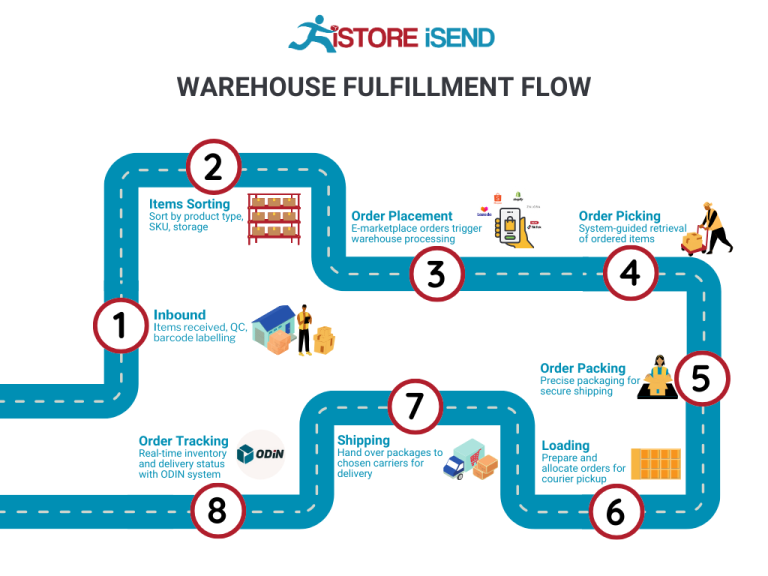
Importance: The packing process not only safeguards products but also enhances the customer experience. Professional packaging reflects a brand’s commitment to quality and can lead to positive reviews and repeat business. Additionally, accurate packing helps in preventing damage during shipping, reducing the risk of returns.
5. Shipping & Delivery
The final step in the order fulfillment process is shipping and delivery, where packed orders are dispatched to customers. This involves selecting the most efficient shipping methods and carriers based on factors such as cost, speed, and reliability.
Businesses can utilize shipping software to streamline this process, allowing for real-time tracking and management of shipments. Key performance indicators (KPIs) such as shipping time and delivery accuracy are monitored to assess the efficiency of the shipping process.
Importance: Timely and reliable shipping is crucial for customer satisfaction and loyalty. In an era where consumers expect quick delivery, optimizing this stage can provide a competitive edge in the e-commerce market. Effective shipping strategies also help manage costs, impacting the overall profitability of the business.
By understanding and optimizing each step of the order fulfillment process, e-commerce businesses can enhance operational efficiency, reduce costs, and improve customer satisfaction, ultimately leading to sustained growth and success in the marketplace.
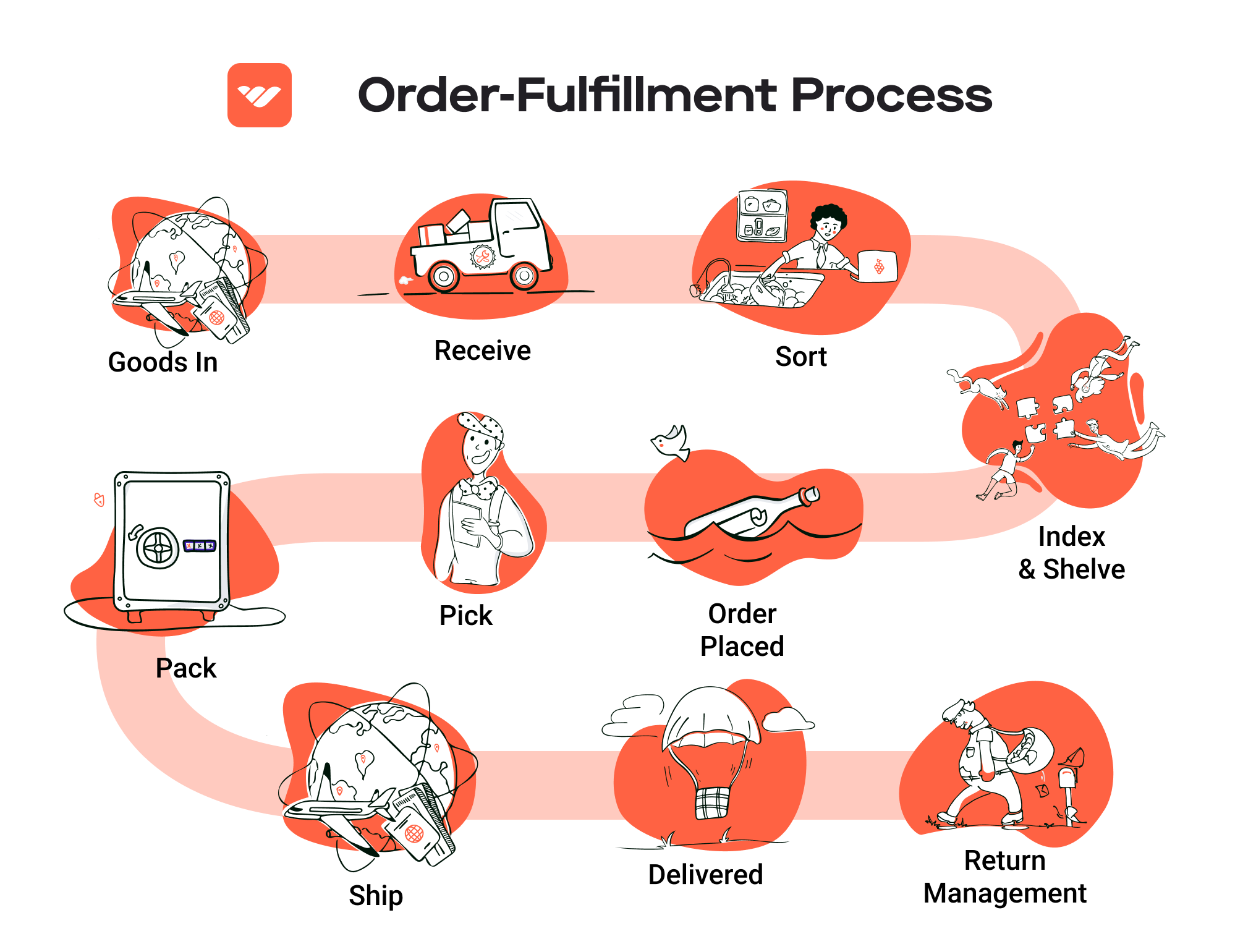
Comparing Fulfillment Models: In-House vs. 3PL vs. Dropshipping
Comparison of Fulfillment Models
| Model | Who Handles Inventory | Best For (Business Stage) | Key Advantage | Key Disadvantage |
|---|---|---|---|---|
| In-House Fulfillment | The business itself | Established businesses with stable demand | Greater control over inventory and quality | High overhead costs and complexity |
| Third-Party Logistics (3PL) | A third-party provider | Growing businesses looking to scale | Flexibility and reduced operational burden | Less control over inventory management |
| Dropshipping | Supplier/vendor | Startups and businesses testing the market | Low upfront investment and risk | Lower profit margins and longer shipping times |
In-House Fulfillment
In-house fulfillment involves managing all logistics, including inventory storage, order processing, and shipping, within your own facilities. This model is typically best suited for established businesses that have a steady demand for their products. The key advantage of in-house fulfillment is the level of control it provides. Businesses can ensure product quality, streamline operations, and create a customized experience for customers. Additionally, having direct oversight of inventory can lead to better forecasting and inventory management, enabling businesses to respond quickly to changes in demand.
However, this model comes with significant downsides. The overhead costs can be substantial, requiring investment in warehousing, technology, and staffing. As demand fluctuates, maintaining a large facility can lead to inefficiencies and wasted resources. Furthermore, the complexities of logistics management can detract from core business activities, making it a less viable option for smaller businesses or those in the early stages of growth.
Third-Party Logistics (3PL)
Third-party logistics (3PL) providers manage logistics operations on behalf of businesses. This model is particularly advantageous for growing businesses looking to scale without the burden of managing logistics internally. By outsourcing fulfillment to a 3PL, businesses can benefit from their expertise, established networks, and economies of scale. This flexibility allows companies to focus on their core competencies, such as product development and marketing, while leaving inventory management, shipping, and returns to the logistics experts.
The primary disadvantage of using a 3PL is the reduced control over inventory management and fulfillment processes. Businesses may face challenges in communication and coordination with their 3PL partners, which can lead to discrepancies in inventory levels and order fulfillment times. Furthermore, relying on a third party means that any issues they encounter, such as shipping delays or inventory shortages, can directly impact your business’s reputation and customer satisfaction.
Dropshipping
Dropshipping is a fulfillment model where the retailer does not hold inventory but instead purchases items from a supplier only after a sale is made. This model is ideal for startups and businesses testing the market, as it requires minimal upfront investment. Entrepreneurs can offer a wide range of products without the financial risk associated with holding inventory. Additionally, dropshipping allows for quick pivoting based on market trends, as businesses can easily switch suppliers or products without being tied to existing stock.
However, dropshipping has notable drawbacks. The profit margins are often lower compared to traditional retail, as suppliers typically charge higher prices for items sold on a dropship basis. Additionally, shipping times can be longer, especially if products are sourced from overseas suppliers. This can lead to customer dissatisfaction if expectations for delivery are not managed properly. Moreover, businesses have less control over product quality and fulfillment processes, which can result in inconsistent customer experiences.
Conclusion
When deciding on a fulfillment model, e-commerce business owners must carefully assess their current stage, operational capabilities, and long-term goals. Each model has its unique advantages and disadvantages that can significantly impact customer satisfaction, operational efficiency, and overall business growth. By understanding these differences, entrepreneurs can make informed decisions that align with their strategic objectives and market demands. Whether opting for in-house fulfillment, leveraging the expertise of a 3PL, or exploring the low-risk opportunity of dropshipping, the right choice will depend on the specific needs of the business and its customers.
A Deep Dive into Amazon FBA: Pros, Cons, and Who It’s For
Understanding Fulfillment by Amazon (FBA)
Fulfillment by Amazon (FBA) is a service offered by Amazon that allows sellers to store their products in Amazon’s fulfillment centers. Amazon then takes care of storage, packaging, and shipping to customers, as well as handling customer service and returns. This means that sellers can leverage Amazon’s vast logistics network and customer service capabilities, which can be a significant advantage for e-commerce businesses looking to scale.
How FBA Works
-
Setting Up: Sellers create an Amazon seller account and list their products on the platform. They can choose to enroll in FBA for specific items or their entire inventory.
-
Shipping to Amazon: Once enrolled, sellers send their products to Amazon’s fulfillment centers. They must follow Amazon’s guidelines for packaging and labeling to ensure smooth processing.
-
Storage: Products are stored in Amazon’s warehouses until they are sold. Sellers are charged storage fees based on the amount of space their inventory occupies.
-
Order Fulfillment: When a customer places an order, Amazon picks, packs, and ships the product directly to the customer. This includes handling all customer service inquiries related to the order.
-
Returns Management: Amazon also manages returns, making it easier for sellers to handle customer dissatisfaction without directly dealing with returns logistics.
-
Reporting and Analytics: Sellers have access to various reporting tools that provide insights into sales performance, inventory levels, and customer feedback.
Pros of Using FBA
Prime Eligibility
Products fulfilled by Amazon automatically qualify for Amazon Prime, giving sellers access to millions of Prime members. This can significantly increase visibility and sales, as Prime members are more likely to purchase items that offer free and fast shipping.
Customer Trust
Amazon is a well-established brand with a strong reputation for customer service. By using FBA, sellers can benefit from this trust, as customers often feel more comfortable purchasing products that are backed by Amazon’s fulfillment network. This can lead to higher conversion rates and customer loyalty.
Multi-Channel Fulfillment
FBA isn’t limited to Amazon sales alone. Sellers can use FBA to fulfill orders from their own websites or other e-commerce platforms. This flexibility allows businesses to streamline their logistics while leveraging Amazon’s expertise in fulfillment.
Simplified Logistics
By outsourcing warehousing, shipping, and customer service to Amazon, sellers can focus on other aspects of their business, such as product development and marketing. This is particularly beneficial for small businesses that may lack the resources to manage logistics effectively.
Scalability
FBA allows sellers to scale their operations without the need for significant investments in warehousing and fulfillment infrastructure. As demand grows, sellers can easily send additional inventory to Amazon without worrying about the logistics of storage and shipping.
Cons of Using FBA
High Fees
While FBA provides many advantages, it comes at a cost. Sellers are charged various fees, including storage fees and fulfillment fees based on the size and weight of the products. These fees can add up quickly, especially for low-margin items, and can eat into profit margins.
Strict Inventory Rules
Amazon has stringent inventory management practices that sellers must adhere to. This includes limitations on the number of units that can be stored and specific guidelines for product preparation and labeling. Sellers who fail to comply may face penalties or have their inventory returned.
Commingling Risks
FBA uses a commingling strategy, which means that products from different sellers are stored together in Amazon’s warehouses. This can lead to issues if a seller’s product is mixed with defective or counterfeit items from other sellers. If a customer receives the wrong product, it can negatively impact the seller’s reputation.
Limited Control
By relying on Amazon for fulfillment, sellers may find themselves with limited control over shipping times, packaging, and customer interactions. If Amazon experiences delays or issues, the seller’s business could suffer as a result.
Inventory Management Challenges
Although FBA simplifies some aspects of logistics, it can complicate inventory management. Sellers must keep track of stock levels across multiple platforms and ensure they do not run out of inventory or overstock items, which can lead to increased storage fees.
Who is FBA Best For?
FBA is best suited for e-commerce businesses that are looking to scale quickly and efficiently. Here are a few types of sellers who may benefit the most from utilizing FBA:
-
Small to Medium-Sized Businesses: Companies with limited resources for logistics can leverage FBA to access Amazon’s infrastructure and expertise.
-
Brands with High Sales Volume: Sellers who have a consistent and high volume of sales can benefit from the efficiencies and Prime eligibility that FBA offers.
-
New Sellers: Entrepreneurs entering the e-commerce space can use FBA to reduce the complexity of logistics, allowing them to focus on growing their business and marketing their products.
-
Multi-Channel Sellers: Businesses selling on multiple platforms can use FBA for streamlined logistics and order fulfillment across different sales channels.
-
Retail Arbitrage or Wholesale Sellers: Those who buy products at lower prices to sell at a profit can benefit from FBA’s fulfillment capabilities, allowing them to scale their operations without investing heavily in logistics.
In conclusion, while FBA presents both opportunities and challenges, it can be a powerful tool for e-commerce businesses looking to enhance their logistics and customer service capabilities. By understanding the pros and cons, sellers can make informed decisions about whether FBA is the right choice for their operations.
Core Services Offered by Fulfillment Centers
Inventory Management & Warehousing
Inventory management is a critical function of fulfillment centers that involves tracking and managing stock levels, orders, sales, and deliveries. Effective inventory management ensures that products are available when customers need them, reducing the risk of stockouts or overstock situations. Fulfillment centers utilize sophisticated inventory management systems that provide real-time data on product availability, allowing e-commerce businesses to make informed decisions about restocking and inventory levels.
The benefits of robust inventory management for e-commerce businesses include:
-
Enhanced Efficiency: By keeping accurate track of stock levels, businesses can streamline their operations, minimizing the time spent on manual inventory counts and reducing errors.
-
Improved Customer Satisfaction: With real-time inventory data, businesses can ensure that popular items are always in stock, leading to quicker fulfillment and increased customer satisfaction.
-
Cost Savings: Effective inventory management reduces carrying costs by optimizing stock levels, thus preventing excess inventory that ties up capital.
-
Data-Driven Insights: Fulfillment centers provide analytics on sales trends and inventory turnover, which helps businesses make strategic decisions about purchasing and marketing.
Pick and Pack Services
Pick and pack services are essential components of the fulfillment process, involving the selection (picking) of items from the warehouse and packaging them (packing) for shipment to customers. Fulfillment centers employ trained staff and automated systems to efficiently handle these tasks, ensuring that orders are fulfilled accurately and quickly.
The benefits of pick and pack services for e-commerce businesses include:
-
Accuracy in Order Fulfillment: With trained personnel and advanced technology, fulfillment centers minimize errors in order picking, reducing the likelihood of incorrect items being shipped.
-
Scalability: As a business grows, fulfillment centers can easily scale their pick and pack operations to meet increased demand, allowing for greater flexibility in handling seasonal spikes or unexpected surges in orders.
-
Time Efficiency: By outsourcing pick and pack operations to a fulfillment center, e-commerce businesses can focus on core activities such as marketing and customer engagement, while the fulfillment center handles logistics.
-
Custom Packaging Options: Fulfillment centers often offer custom packaging solutions that enhance brand presentation, allowing businesses to create a memorable unboxing experience for their customers.
Kitting and Assembly
Kitting and assembly services involve the bundling of different products into a single package or the assembly of components into a finished product before shipment. This service is particularly beneficial for e-commerce businesses that sell multi-item orders or require assembly of products.
The benefits of kitting and assembly services for e-commerce businesses include:
-
Streamlined Operations: By pre-packaging items or assembling products before they are ordered, businesses can significantly reduce the time it takes to fulfill orders, leading to faster shipping times.
-
Cost Efficiency: Kitting can lower shipping costs by reducing the number of packages sent out, which can also lead to discounts from shipping carriers.
-
Enhanced Product Presentation: Kitted products can be packaged in a way that is more appealing to customers, which can enhance the perceived value and encourage repeat purchases.
-
Inventory Optimization: Kitting helps in managing inventory more effectively by combining items that are frequently purchased together, thus simplifying the inventory management process.
Returns Management (Reverse Logistics)
Returns management, or reverse logistics, is the process of handling product returns from customers. Fulfillment centers provide comprehensive returns management services that include processing returns, restocking items, and managing customer refunds or exchanges. This service is essential for maintaining customer satisfaction and loyalty in e-commerce.
The benefits of effective returns management for e-commerce businesses include:
-
Customer Retention: A streamlined returns process enhances customer experience, as it provides a hassle-free way for customers to return products, which can lead to increased loyalty and repeat purchases.
-
Data Insights: Fulfillment centers can analyze return data to identify trends and reasons for returns, allowing businesses to make informed decisions about product quality, marketing strategies, and inventory management.
-
Cost Control: Efficient handling of returns can minimize losses associated with returned products, such as restocking fees and shipping costs, ultimately improving the bottom line.
-
Reconditioning and Reselling: Fulfillment centers often have processes in place to refurbish or repackage returned items, allowing businesses to resell them at a reduced price, recouping some of the costs associated with returns.
In summary, leveraging the core services offered by fulfillment centers can significantly enhance the operational efficiency, customer satisfaction, and overall profitability of e-commerce businesses. By utilizing these services, businesses can focus on growth and scaling their operations while leaving logistics to the experts.
How to Choose a Fulfillment Partner: A 6-Point Checklist
Location & Warehouse Network
Importance: The geographic location of your fulfillment partner’s warehouses is crucial for minimizing shipping times and costs. A partner with strategically located facilities can significantly enhance your delivery efficiency, particularly if you serve a wide customer base across various regions.
Questions to Ask:
– Where are your warehouses located, and how does that align with my target market?
– How many distribution centers do you operate, and what is their capacity?
– Can you provide insights into your shipping rates based on these locations?
Technology & Integrations
Importance: In today’s fast-paced e-commerce environment, technology plays a vital role in managing inventory, processing orders, and providing real-time data. A fulfillment partner with robust technology can streamline your operations and enhance the customer experience.
Questions to Ask:
– What technology platforms do you use for inventory management and order processing?
– Can your systems integrate with my e-commerce platform (e.g., Shopify, WooCommerce)?
– How do you ensure data accuracy and minimize errors in order fulfillment?
Specializations (e.g., cold storage, oversized items)
Importance: Depending on your product line, you may require specific types of storage and handling. For instance, if you sell perishable goods, you need a partner with cold storage capabilities. If you deal with oversized items, you should ensure your fulfillment partner can handle such products efficiently.
Questions to Ask:
– Do you offer specialized services such as cold storage or handling oversized items?
– What measures do you have in place to ensure the quality and safety of specialized products?
– Can you provide examples of how you’ve successfully handled similar products for other clients?
Scalability & Capacity
Importance: As your business grows, your fulfillment needs will likely change. A good fulfillment partner should be able to scale operations in line with your growth, ensuring you can meet increased demand without service interruptions.
Questions to Ask:
– How do you handle fluctuations in order volume, particularly during peak seasons?
– What is your current capacity, and how do you plan to expand in the future?
– Can you provide case studies or examples of how you’ve scaled operations for other clients?
Pricing and Contracts
Importance: Understanding pricing structures and contract terms is essential to avoid unexpected costs that can erode your profit margins. Transparent pricing models help you budget effectively and assess the value you’re getting from your fulfillment partner.
Questions to Ask:
– What are your pricing models (e.g., per order, per item, monthly fees)?
– Are there any additional fees I should be aware of (e.g., storage, pick-and-pack fees)?
– Can you provide a sample contract, and what are the terms for termination or renegotiation?
Customer Support & Reviews
Importance: Exceptional customer support is vital when issues arise, whether it’s a shipping delay or a system error. Partnering with a fulfillment provider that has a strong reputation for customer service can save you time, stress, and potential loss of sales.
Questions to Ask:
– What support channels do you offer (e.g., phone, email, chat), and what are your response times?
– Can you provide references or testimonials from current or past clients?
– How do you handle service disruptions or unexpected challenges, and what proactive measures do you take to prevent them?
Conclusion
Choosing the right fulfillment partner is a pivotal decision that can significantly impact your e-commerce business’s success. By utilizing this checklist, you can evaluate potential partners effectively, ensuring they align with your operational needs and growth ambitions. Remember, the right partner not only enhances your logistics but also contributes to a seamless customer experience, allowing you to focus on scaling your business.
Understanding Fulfillment Pricing: A Breakdown of Common Fees
Initial Setup Fees
Initial setup fees are one-time charges that e-commerce businesses incur when they begin using a fulfillment service. These fees can vary significantly depending on the provider and the complexity of the setup required. Typically, they cover the costs associated with integrating your online store with the fulfillment center’s systems, setting up inventory management, and configuring order processing.
To calculate initial setup fees, fulfillment centers may consider factors such as the number of SKUs (stock-keeping units) you need to onboard, the level of customization required for your logistics processes, and any specific technology integrations. For small businesses, these fees can range from a few hundred to several thousand dollars, depending on the scale and sophistication of the operation.
Receiving Fees
Receiving fees are charged when inventory arrives at the fulfillment center. This fee compensates the fulfillment provider for the labor and resources required to unload, inspect, and store incoming products.
Typically, receiving fees are calculated based on the volume of goods received, often measured in units or pallets. Some providers may also charge for additional services, such as labeling or repackaging items upon arrival. It’s important to clarify whether receiving fees are charged per shipment or per item, as this can significantly affect overall costs, especially for businesses with frequent inventory arrivals.
Storage Fees (per pallet/bin)
Storage fees are ongoing charges for the space your inventory occupies within the fulfillment center. These fees are typically calculated on a per-pallet or per-bin basis and can vary depending on the size and type of storage required.
For instance, standard storage fees might apply to regular pallets, while specialized storage (for hazardous materials, climate-controlled products, etc.) may incur higher fees. Some fulfillment centers also offer tiered pricing, where the cost per pallet decreases as your storage volume increases. Understanding the specific pricing structure of your chosen fulfillment provider is crucial for accurate budgeting, as storage costs can accumulate quickly, especially for slow-moving inventory.
Pick & Pack Fees (per item/order)
Pick and pack fees are charged for the labor involved in retrieving items from storage and preparing them for shipment. This process includes picking the items, packing them securely, and labeling them for delivery.
The calculation of pick and pack fees can vary widely among providers. Some may charge a flat fee per order, while others may charge based on the number of items included in each order. It’s essential to consider your average order size and frequency when evaluating potential costs. For businesses with higher order volumes or complex order requirements, negotiating lower pick and pack fees can lead to significant savings.
Shipping Fees
Shipping fees are perhaps the most variable and significant costs associated with fulfillment services. These fees cover the transportation of orders from the fulfillment center to the customer’s doorstep and can vary based on several factors, including:
- Shipping Method: Standard, expedited, or same-day delivery options will have different price points.
- Destination: Shipping to remote or international locations often incurs higher fees.
- Weight and Dimensions: Heavier and larger packages typically cost more to ship.
Fulfillment centers may offer discounted shipping rates through partnerships with major carriers, which can benefit your overall shipping costs. When assessing shipping fees, it’s crucial to understand the pricing model—whether it’s a flat rate, weight-based, or zone-based pricing—to avoid unexpected charges.
Tips for Getting an Accurate Quote
-
Provide Detailed Information: When requesting a quote, be as detailed as possible about your product types, order volumes, and shipping destinations. This helps fulfillment providers give you a more accurate estimate.
-
Ask About Discounts: Inquire about volume discounts, seasonal pricing, or any promotional offers that could reduce your overall costs.
-
Understand Fee Structures: Clarify how each fee is calculated to avoid surprises later. Ask if there are any hidden fees or additional charges that could arise.
-
Compare Multiple Providers: Don’t settle for the first quote you receive. Compare offerings from different fulfillment centers to find the best balance of service and cost.
-
Negotiate Terms: If you anticipate high volumes, leverage that potential to negotiate lower fees or better service terms with your chosen fulfillment provider.
By understanding these common fulfillment pricing models and following these tips, e-commerce business owners can make more informed decisions that align with their logistics needs and financial goals.
Frequently Asked Questions (FAQs) about Fulfillment
1. What led to the closure of the Walmart Sam’s Club fulfillment center in Fort Worth, Texas?
Walmart is closing the Sam’s Club fulfillment center in Fort Worth as part of a strategic shift to upgrade its e-commerce operations. The closure allows for the relocation of operations to a newer, high-tech facility in Lancaster, Texas, designed to enhance efficiency and improve service quality for customers.
2. How many employees are affected by the closure?
The Fort Worth fulfillment center employs just under 200 staff members. Walmart is providing these employees with transfer options to other facilities and offering a relocation bonus of $7,500 for those who choose to move to the new Lancaster site or other fulfillment centers.
3. What happens to the operations that were based in the closed fulfillment center?
Operations from the Fort Worth center will be relocated to the next-generation fulfillment center in Lancaster, as well as to three other facilities in the Dallas area. This transition aims to ensure continued service and minimize disruptions in order fulfillment.
4. How does this closure impact Walmart’s overall fulfillment network?
While the closure may seem detrimental, Walmart positions it as an evolution of its fulfillment network. The company is investing in high-tech facilities to improve delivery speeds and operational efficiency, enabling it to better compete with e-commerce giants like Amazon.
5. What’s the difference between a warehouse and a fulfillment center?
A warehouse is primarily used for storage of goods, while a fulfillment center is a specialized facility designed to process orders and ship them directly to customers. Fulfillment centers focus on order processing, packing, and shipping, often utilizing technology to streamline these operations.
6. What is a 3PL (Third-Party Logistics)?
A 3PL, or Third-Party Logistics provider, is a service that manages a company’s logistics operations, including transportation, warehousing, and fulfillment. Businesses often partner with 3PLs to leverage their expertise, technology, and infrastructure, allowing them to focus on core activities while improving supply chain efficiency.
7. How much do fulfillment services typically cost?
The cost of fulfillment services can vary widely based on factors such as order volume, storage space required, and specific services needed (e.g., packaging, shipping, inventory management). On average, businesses can expect to pay anywhere from $2 to $5 per order, with additional fees for storage and other services. It’s advisable to compare quotes from multiple providers to find the best fit for your business needs.
8. Will there be any impact on delivery times for Sam’s Club orders?
Walmart has stated that there should be no adverse effects on delivery times due to the closure of the Fort Worth fulfillment center. The company’s investment in new facilities and technology is designed to maintain or even improve delivery efficiency.
9. What options are available for employees affected by the fulfillment center closure?
Affected employees have several options: they can choose to relocate to the new Lancaster facility or other fulfillment centers within Walmart’s network, with a $7,500 transfer bonus. Alternatively, they can explore other job opportunities within Walmart or choose to leave the company.
10. How can e-commerce businesses prepare for similar fulfillment center closures?
E-commerce businesses should maintain a flexible supply chain strategy by diversifying their fulfillment partnerships and investing in technology that enhances operational agility. Regularly reviewing logistics networks and having contingency plans in place can help mitigate the impact of unexpected closures or changes in fulfillment operations.
Conclusion: Is Outsourcing Fulfillment the Right Move for Your Business?
Evaluating the Benefits of Outsourcing Fulfillment
Outsourcing your fulfillment operations can be a transformative decision for your e-commerce business. By leveraging a specialized fulfillment partner, you can unlock a range of benefits that significantly enhance your operational efficiency and scalability.
One of the most compelling advantages of outsourcing fulfillment is time savings. Managing logistics in-house demands substantial resources, from warehousing and inventory management to shipping and returns processing. By entrusting these responsibilities to a fulfillment center, you can redirect your focus toward core business activities such as marketing, product development, and customer engagement. This shift not only improves productivity but also accelerates your business growth.
Additionally, partnering with a fulfillment service provides the scalability necessary to adapt to fluctuating market demands. As your sales increase, fulfillment centers can easily scale operations to accommodate higher order volumes, seasonal spikes, or new product launches without the need for extensive capital investments in infrastructure. This flexibility enables you to respond swiftly to market changes and customer needs, a critical factor in maintaining a competitive edge.
Moreover, fulfillment services bring expertise to the table. These providers specialize in logistics and have the technology and knowledge required to optimize shipping routes, manage inventory effectively, and ensure compliance with regulations. This level of expertise can lead to reduced shipping costs, improved delivery times, and enhanced customer satisfaction.
However, the key to reaping these benefits lies in choosing the right fulfillment partner. Not all providers offer the same level of service or technological capability, so it’s essential to conduct thorough research and consider factors such as reliability, technology integration, and customer service.
Next Steps
To determine if outsourcing fulfillment is the right move for your business, conduct a comprehensive audit of your current shipping processes. Identify pain points, assess costs, and evaluate your capacity for growth. This strategic analysis will help you make an informed decision on whether partnering with a fulfillment service aligns with your long-term business goals. Embrace the opportunity to streamline your operations and focus on what truly matters: scaling your business.
Important Disclaimer
⚠️ Important Disclaimer
The information in this guide is for educational purposes. Fulfillment services, pricing, and platform features change frequently. Always conduct your own due diligence and consult with providers directly before making business decisions.
